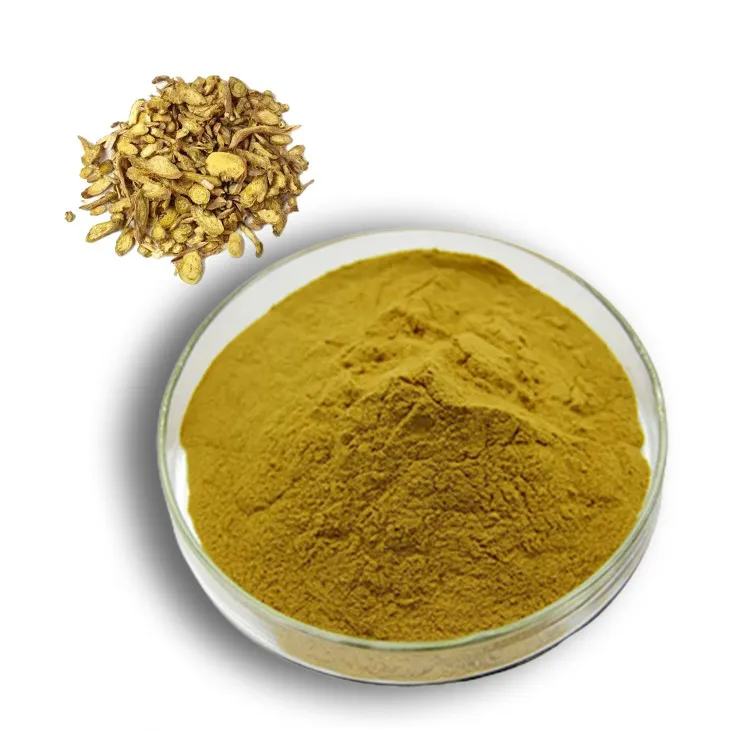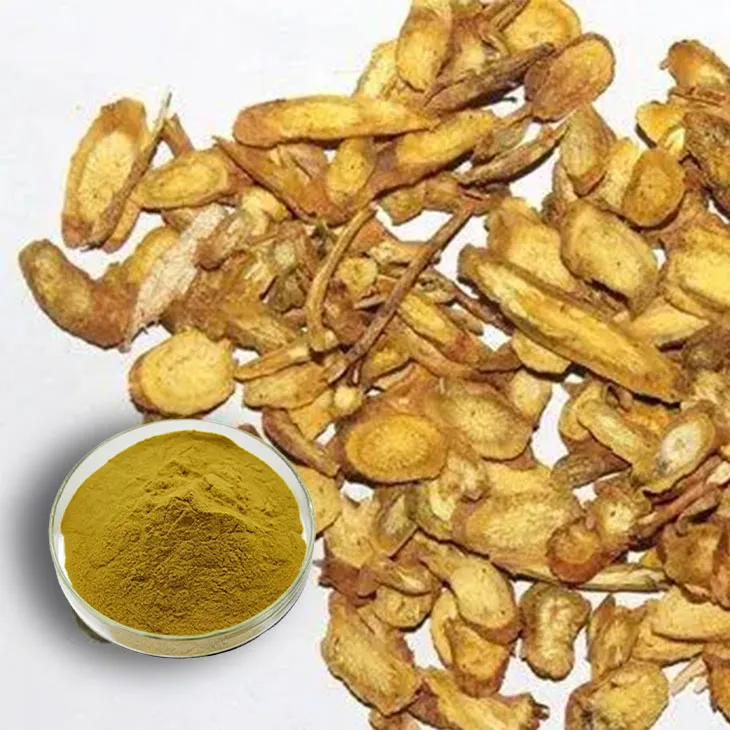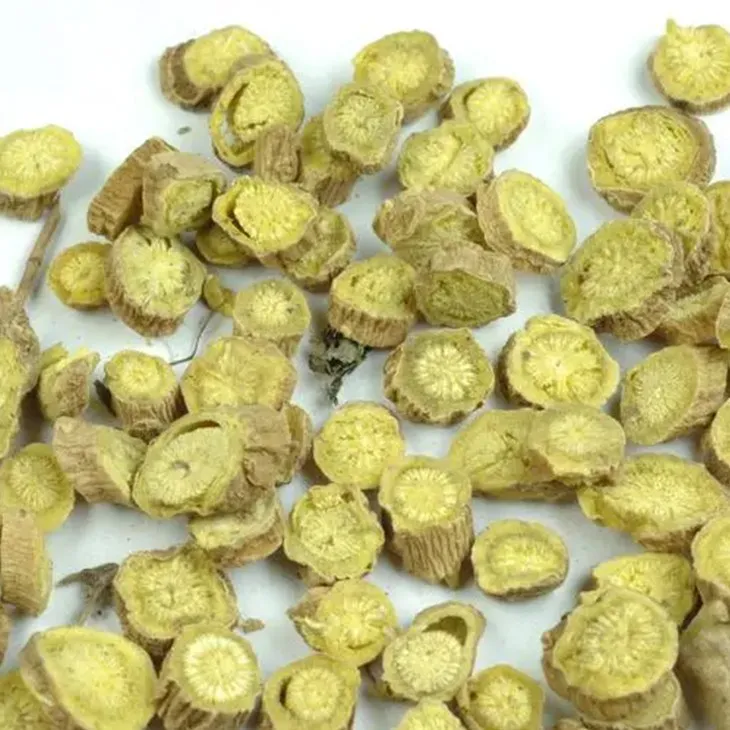- 0086-571-85302990
- sales@greenskybio.com
The process of extracting baicalein from baicalin.
2024-11-26

1. Introduction
Baicalein, a flavonol compound, has attracted significant attention due to its various biological activities such as antioxidant, anti - inflammatory, and anticancer properties. Baicalin, which can be obtained from the roots of Scutellaria baicalensis, is a major precursor for the extraction of baicalein. The extraction process of baicalein from Baicalin is a complex but well - studied procedure that involves multiple steps to ensure high - quality product for various applications in the pharmaceutical, cosmetic, and food industries.

2. Raw Material Preparation
2.1 Collection of Scutellaria baicalensis
The first step in the extraction of baicalein from Baicalin is the proper collection of Scutellaria baicalensis. This plant is typically harvested at the appropriate time to ensure the maximum content of baicalin. The collection process should be carried out carefully to avoid damage to the roots, which are the main part containing baicalin.2.2 Cleaning and Drying
After collection, the roots need to be thoroughly cleaned to remove dirt, debris, and other impurities. Then, the cleaned roots are dried. Drying can be achieved through natural drying in a well - ventilated area or using artificial drying methods such as in an oven at a controlled temperature. The dried roots are then ground into a fine powder for further extraction processes.
3. Baicalin Extraction
3.1 Organic Solvent Extraction
One of the most common methods for extracting baicalin from the powdered roots of Scutellaria baicalensis is through organic solvent extraction. Ethanol and methanol are frequently used solvents. The extraction process involves soaking the powdered roots in the solvent for a certain period of time, usually several hours to days. This allows the baicalin to dissolve into the solvent.3.2 Soxhlet Extraction
Soxhlet extraction is another method that can be used. In this method, the powdered plant material is placed in a Soxhlet extractor, and the solvent is continuously recycled through the sample. This method is more efficient in extracting baicalin compared to simple soaking as it provides continuous extraction over a longer period of time.
4. Hydrolysis of Baicalin to Baicalein
Once baicalin has been extracted, the next step is to hydrolyze it to obtain baicalein. This hydrolysis process can be achieved through chemical or enzymatic methods.
4.1 Chemical Hydrolysis
Chemical hydrolysis typically involves the use of acids or bases. For example, treatment with hydrochloric acid can break the glycosidic bond in baicalin, converting it into baicalein. However, this method requires careful control of reaction conditions such as temperature, pH, and reaction time to avoid unwanted side reactions.4.2 Enzymatic Hydrolysis
Enzymatic hydrolysis uses specific enzymes to break the glycosidic bond. Enzymes such as glycosidases can be used. This method has the advantage of being more specific and milder compared to chemical hydrolysis, resulting in less by - product formation.
5. Purification of Baicalein
After hydrolysis, the resulting baicalein needs to be purified to obtain a high - quality product.
5.1 pH - based Precipitation
Baicalein has different solubility properties at different pH values. By adjusting the pH of the solution, baicalein can be precipitated out while impurities remain in solution. For example, at a certain acidic pH, baicalein may become less soluble and can be separated from the solution by filtration or centrifugation.5.2 Column Chromatography
Column chromatography is a more sophisticated purification method. Different types of columns such as silica gel columns or reversed - phase columns can be used. The sample is loaded onto the column, and baicalein is separated from other components based on its different affinities to the stationary phase and the mobile phase.6. Quality Control
6.1 High - Performance Liquid Chromatography (HPLC)
HPLC is a powerful analytical tool for quantifying baicalein in the final product. It can accurately determine the concentration of baicalein by comparing the peak area of the sample with that of a known standard. This helps to ensure that the product meets the required purity and quantity standards.6.2 Nuclear Magnetic Resonance (NMR)
NMR is used for structure identification of baicalein. It provides detailed information about the chemical structure of baicalein, ensuring that the extracted compound is indeed baicalein and not any other related compounds.7. Conclusion
The extraction of baicalein from baicalin is a multi - step process that requires careful attention at each stage. From the raw material preparation of Scutellaria baicalensis to the final quality control steps, each step plays a crucial role in obtaining a high - quality baicalein product. With the increasing demand for baicalein in various industries, continuous research and improvement in the extraction process are necessary to ensure its sustainable production and wide - range applications.
FAQ:
What are the common organic solvents used in baicalin extraction?
Common organic solvents used in baicalin extraction include ethanol, methanol, and ethyl acetate. These solvents are effective in dissolving baicalin from Scutellaria baicalensis due to their solubility properties. Ethanol is often preferred as it is relatively safe and can be easily removed during the subsequent purification steps.
How does hydrolysis of baicalin to baicalein occur?
The hydrolysis of baicalin to baicalein usually occurs under acidic or enzymatic conditions. Acid - catalyzed hydrolysis is a common method. For example, treatment with dilute hydrochloric acid can break the glycosidic bond in baicalin, releasing the aglycone baicalein. Enzymatic hydrolysis can also be used, where specific enzymes are employed to selectively cleave the bond, which may offer more selectivity and milder reaction conditions compared to acid hydrolysis.
What is the principle behind pH - based precipitation in the purification of baicalein?
pH - based precipitation takes advantage of the different solubility of baicalein at different pH values. Baicalein may be more soluble at certain pH ranges and less soluble at others. By adjusting the pH of the solution, it is possible to precipitate baicalein out of the solution while leaving impurities in the solution. For example, at a specific acidic pH, baicalein may form insoluble salts or complexes that can be easily separated by filtration or centrifugation.
How does column chromatography work in the purification of baicalein?
Column chromatography is based on the differential adsorption and desorption of components in a mixture. In the case of purifying baicalein, a stationary phase (such as silica gel) is packed into a column. The sample containing baicalein and impurities is loaded onto the top of the column. A mobile phase (a solvent or a mixture of solvents) is then passed through the column. Baicalein and other components will interact differently with the stationary phase. Components that have a weaker interaction with the stationary phase will be eluted first, while baicalein, depending on its specific interaction, will be eluted at a certain time, thus achieving separation from other impurities.
Why is HPLC important for quality control of baicalein?
HPLC (High - Performance Liquid Chromatography) is important for quality control of baicalein because it can accurately quantify the amount of baicalein in a sample. It separates the components in a sample based on their different interactions with the stationary and mobile phases. By comparing the retention time and peak area of the baicalein in the sample with a standard, the concentration of baicalein can be determined precisely. This helps to ensure that the final product contains the appropriate amount of baicalein and meets the required quality standards.
Related literature
- Extraction and Purification of Baicalein from Scutellaria baicalensis: A Review"
- "Optimization of Baicalein Production from Baicalin: A Process - Oriented Study"
- "Analytical Methods for Baicalein Quantification in Herbal Extracts"
- ▶ Hesperidin
- ▶ Citrus Bioflavonoids
- ▶ Plant Extract
- ▶ lycopene
- ▶ Diosmin
- ▶ Grape seed extract
- ▶ Sea buckthorn Juice Powder
- ▶ Fruit Juice Powder
- ▶ Hops Extract
- ▶ Artichoke Extract
- ▶ Mushroom extract
- ▶ Astaxanthin
- ▶ Green Tea Extract
- ▶ Curcumin
- ▶ Horse Chestnut Extract
- ▶ Other Product
- ▶ Boswellia Serrata Extract
- ▶ Resveratrol
- ▶ Marigold Extract
- ▶ Grape Leaf Extract
- ▶ New Product
- ▶ Aminolevulinic acid
- ▶ Cranberry Extract
- ▶ Red Yeast Rice
- ▶ Red Wine Extract
-
Black Rice Extract
2024-11-26
-
Calendula Extract
2024-11-26
-
Fig Extract
2024-11-26
-
Curcuma Longa Extract
2024-11-26
-
Beta Carotene
2024-11-26
-
Lily extract
2024-11-26
-
Citrus Aurantii Extract
2024-11-26
-
Grape Seed Extract
2024-11-26
-
Saffron Extract Powder
2024-11-26
-
Fenugreek Extract Powder
2024-11-26





















